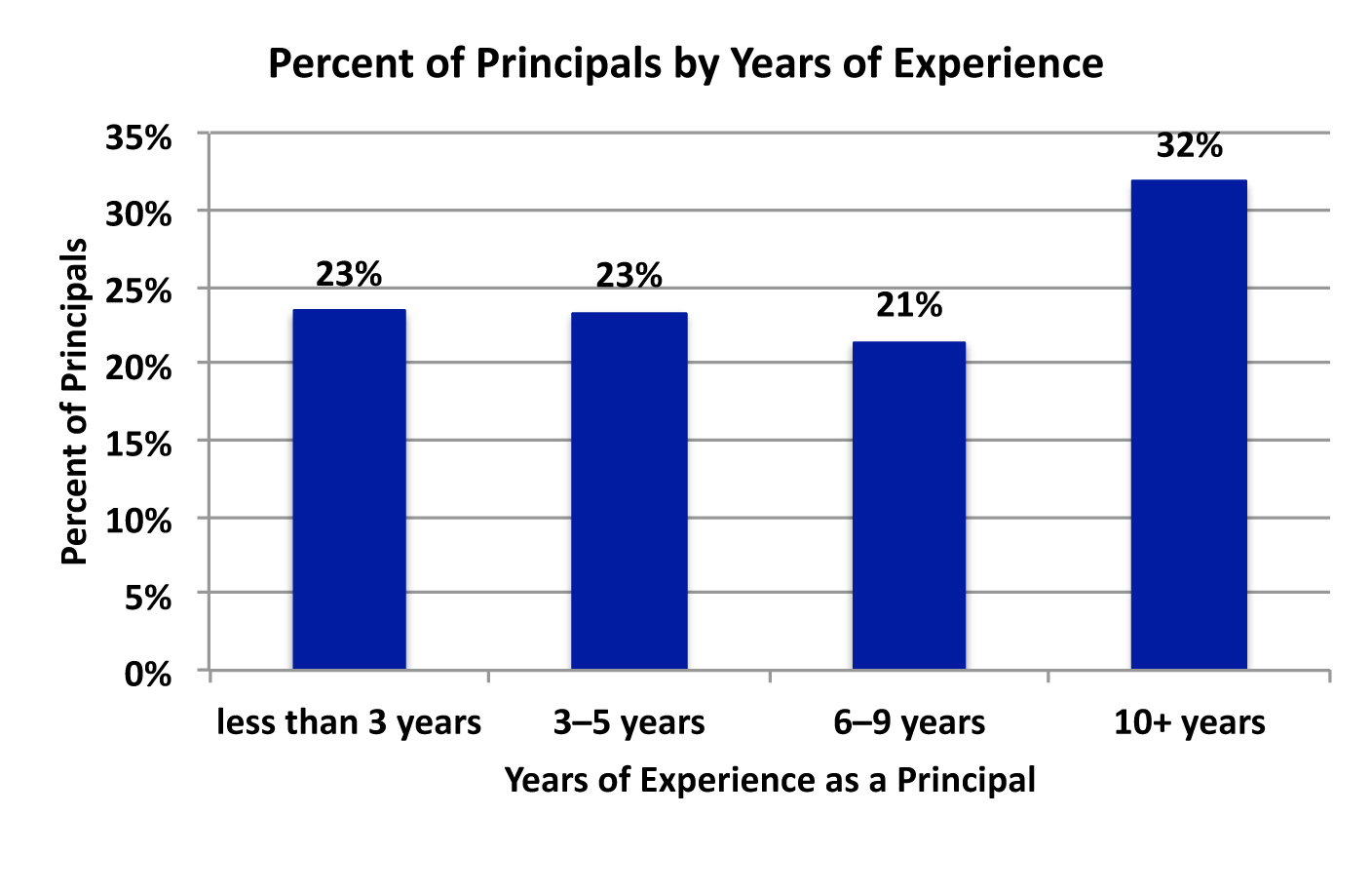What is the experience level of school principals, in the role of principal?
Why is this question important? School principals are the second most important school-related factor, after teachers, in influencing student performance, accounting for about a quarter of total school effects (Marzano, Waters, & McNulty, 2005). There is increasingly clear evidence as to which practices of principals are associated with teaching effectiveness, student achievement, and high-performing schools (Robinson, Lloyd, & Rowe, 2008). One of the primary development strategies for principals is on-the-job experience. Research suggests that principals become more effective with experience, especially in the first 3 years (Seashore Louis, Leithwood, Wahlsrom, & Anderson, 2010; Béteille, Kalogrides, & Loeb, 2012; Branch, Hanushek, & Rivkin, 2012). Given the importance of on-the-job experience, tracking this metric is valuable in identifying trends, ascertaining where turnover is the greatest, and providing a baseline for change efforts.
See further discussion below.

Results: Of the 114,330 school principals in the United States in 2012–13, almost a quarter (23.4%) had less than 3 years' experience as a school principal; nearly one half (46.7%) had up to 5 years' experience; and fewer than one third (31.8%) had more than 10 years' experience on the job.
Implications: Given the importance of experience in the development of effective principals, the data highlight a challenge to the current system for principal development. A significant percentage of principals have little on-the-job experience. The consequence is a need for extensive training, support, and feedback to assist new principals and to promote retention of and quality performance in all principals.
Study Description: The 2012–13 Principal Follow-up Survey (PFS) is a component of the Schools and Staffing Survey (SASS), a nationally representative sample survey of public and private K–12 schools, principals, and teachers in the 50 states and District of Columbia. The purpose of the SASS is to collect information that can provide a detailed picture of U.S. elementary and secondary schools and their staff. It was developed by the National Center for Education Statistics (NCES) of the Institute of Education Sciences within the U.S. Department of Education and was conducted by the U.S. Census Bureau.
The SASS covers a wide range of topics including teacher demand, teacher and principal characteristics, general conditions in schools, principals' and teachers' perceptions of school climate and problems in their schools, teacher compensation, district hiring and retention practices, and basic characteristics of the student population.
Citation:
Béteille, T., Kalogrides, D., & Loeb, S. (2012). Stepping stones: Principal career paths and school outcomes. Social Science Research, 41(4), 904–919.
Branch, G. F., Hanushek, E. A., & Rivkin, S. G. (2012). Estimating the effect of leaders on public sector productivity: The case of school principals (No. w17803). Cambridge, MA: National Bureau of Economic Research.
* Goldring, R., & Taie, S., (2014). Principal attrition and mobility: Results from the 2012–13 principal follow-up survey, first look. (NCES 2014-064). U.S. Department of Education. Washington, DC: National Center for Education Statistics.
Marzano, R. J., Waters, T., & McNulty, B. A. (2005). School leadership that works: From research to results. Alexandria, VA: Association for Supervision and Curriculum Development.
Robinson, V. M. J., Lloyd, C. A., & Rowe, K. J. (2008). The impact of leadership on student outcomes: An analysis of the differential effects of leadership types. Educational Administration Quarterly, 44(5), 635–674.
Seashore Louis, K., Leithwood, K., Wahlstrom, K. L., & Anderson, S. E. (2010). Investigating the links to improved student learning: Final report of research findings. New York, NY: The Wallace Foundation.
*study from which graph data were derived
